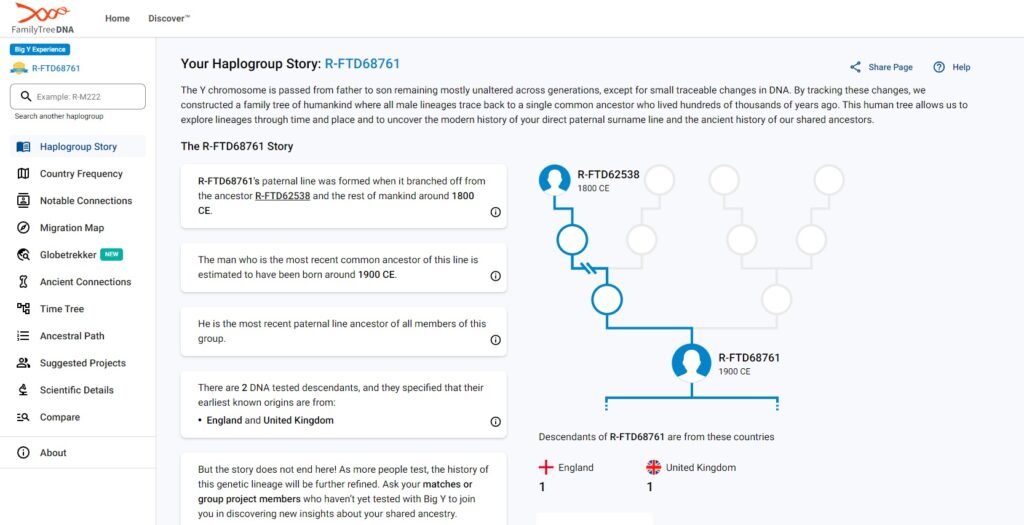How did Y-DNA help determine the parentage of Francis Kendall? For the answer to that question to make sense, some basic knowledge of Y-DNA is required.
What is Y-DNA?
Y-DNA is passed down only by males to males.[1] It is a direct father to son transmission for every generation in a paternal line. Women do not carry Y-DNA, not even from their fathers. It is part of the Y chromosome, which women do not get. Y-DNA changes only a little over many generations so a father’s or even a great grandfather’s Y-DNA may be identical to a son’s or great grandson’s. Or it may change, but minute differences can only be detected by a specific Y-DNA test.
Y-DNA vs atDNA
Y-DNA, as stated, changes little over multiple generations of males, but autosomal DNA (atDNA) changes a lot with every generation.[2] Autosomal DNA is the test most of us are familiar with, being done by Ancestry, 23 and Me, FamilyTreeDNA, My Heritage and others. Male and female children in any given family can make use of autosomal testing because every person inherits approximately half their autosomal DNA from each parent and every succeeding generation does the same. Autosomal DNA is quickly watered down as it passes through multiple generations, so a great grandparent and a great grandchild share only 12.5% (or less) of their DNA. That is a large difference from the 100% or nearly 100% inheritance of Y-DNA over the same number of paternal generations.
Y-DNA and surnames
Typically, Y-DNA goes hand in hand with the transmission of a surname in European/European-settled cultures (like North and South America) and in many Asian countries. However, surnames and Y-DNA do not always go hand in hand because of NPEs.[3] Whether the acronym stands for Non-Paternity (or Non-Parental) Event, or Not the Parent Expected, the meaning of the term is that the paper trail and DNA results are not a match. This may happen for several reasons including illegitimacy, adoption, use of alias surnames and the fluidity of surnames, intentional name changes, and more. When using Y-DNA as evidence to build a family tree, caution about what to expect should always be exercised.

Haplogroups
To make it easier to work with DNA of any kind, closely related individuals are grouped together.[4] DNA-related groups are called haplogroups or haplotypes if detailed Y-DNA testing is done (which we will not get into here as it’s a bit complex). Haplogroup designations are named using letters of the alphabet which are followed by strings of other letters and numbers (like R-FTD62538). If two testers compare their haplogroups and they share initial letters and many numbers match down the line, they are more closely related than two people who do not share the same initial letters or numbers.
Y-DNA Mutations
Though it has been emphasized that Y-DNA changes little, it does have small mutations like all other types of DNA.[5] It is the number and placement of those mutations that can tell us how closely two individuals are related. If there are many mutations for individuals in the same general haplogroup, their common ancestors lived long ago, likely before recorded history. If there are very few mutations, there is a chance a common ancestor can be found within the last four to five centuries in historical documents.
How can Y-DNA be used for genealogical research?
Y-DNA can be used as proof of relatedness. A recent issue of NGS Magazine outlined ways Y-DNA can be used for genealogical evidence.[6]
- Y-DNA can be used to identify how closely related living males are to each other
- Y-DNA can help identify distant ancestors
- Y-DNA may identify surname changes
- Y-DNA evidence (in fact all DNA evidence) can work with paper documentation to fill out a family tree
As this list shows, a Y-DNA test is a very useful research tool for researching paternal ancestry. The test is always worth taking (or finding a male relative to take) when investigating a paternal line. How Y-DNA evidence helped find the correct parentage of Francis Kendall will be covered in another post.
[1] Blaine Bettinger, The Family Tree Guide to DNA Testing and Genetic Genealogy (United States of America: Penguin Random House, 2019), 93.
[2] Bettinger, The Family Tree Guide, 52-56.
[3] Graham S. Holton, Tracing Your Ancestors Using DNA (Barnsley, South Yorkshire: Pen & Sword Books, Ltd, 2019), 181-182.
[4] Bettinger, The Family Tree Guide, 105-107.
[5] Bettinger, The Family Tree Guide, 106-109.
[6] Paul Woodbury, “The Journey of DNA’s Inheritance Paths: mtDNA and Y-DNA,” NGS Magazine vol 45 number 4 (Oct-Dec 2019): 60-60.
